实用科技英语翻译-期末考试复习题
- 格式:doc
- 大小:62.50 KB
- 文档页数:9
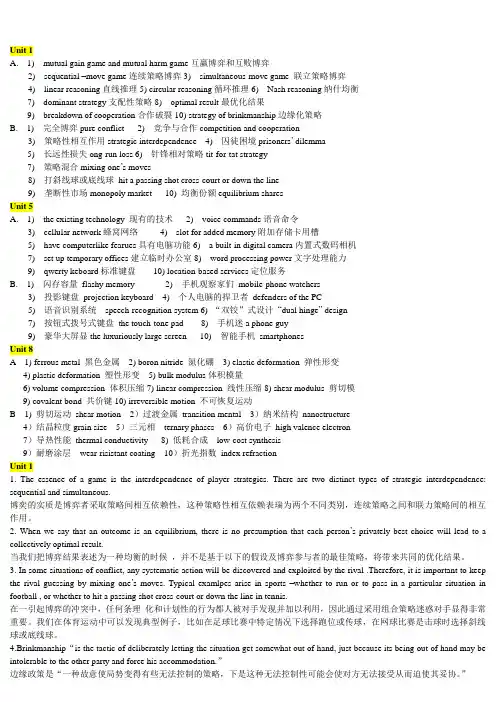
Unit 1A. 1) mutual gain game and mutual harm game互赢博弈和互败博弈2) sequential –move game连续策略博弈3) simultaneous-move game 联立策略博弈4) linear reasoning直线推理5) circular reasoning循环推理6) Nash reasoning纳什均衡7) dominant strategy支配性策略8) optimal result最优化结果9) breakdown of cooperation合作破裂10) strategy of brinkmanship边缘化策略B. 1) 完全博弈pure conflict 2) 竞争与合作competition and cooperation3) 策略性相互作用strategic interdependence 4) 囚徒困境prisoners’ dilemma5) 长远性损失ong-run loss 6) 针锋相对策略tit-for-tat strategy7) 策略混合mixing one’s moves8) 打斜线球或底线球hit a passing shot cross-court or down the line9) 垄断性市场monopoly market 10) 均衡份额equilibrium sharesUnit 5A. 1) the existing technology 现有的技术2) voice commands语音命令3) cellular network蜂窝网络4) slot for added memory附加存储卡用槽5) have computerlike fearues具有电脑功能6) a built-in digital camera内置式数码相机7) set up temporary offices建立临时办公室8) word processing power文字处理能力9) qwerty keboard标准键盘10) location-based services定位服务B. 1) 闪存容量flashy memory 2) 手机观察家们mobile-phone watchers3) 投影键盘projection keyboard 4) 个人电脑的捍卫者defenders of the PC5) 语音识别系统speech-recognition system 6) “双铰”式设计―dual hinge‖ design7) 按钮式拨号式键盘the touch-tone pad 8) 手机迷a phone guy9) 豪华大屏显the luxuriously large screen 10) 智能手机smartphonesUnit 8A 1) ferrous metal 黑色金属2) boron nitride 氮化硼3) elastic deformation 弹性形变4) plastic deformation 塑性形变5) bulk modulus体积模量6) volume compression 体积压缩7) linear compression 线性压缩8) shear modulus 剪切模9) covalent bond 共价键10) irreversible motion 不可恢复运动B 1) 剪切运动shear motion 2)过渡金属transition mental 3)纳米结构nanostructure4)结晶粒度grain size 5)三元相ternary phases 6)高价电子high valence electron7)导热性能thermal conductivity 8) 低耗合成low-cost synthesis9)耐磨涂层wear-risistant coating 10)折光指数index refractionUnit 11. The essence of a game is the interdependence of player strategies. There are two distinct types of strategic interdependence: sequential and simultaneous.博奕的实质是博弈者采取策略间相互依赖性,这种策略性相互依赖表瑞为两个不同类别,连续策略之间和联力策略间的相互作用。
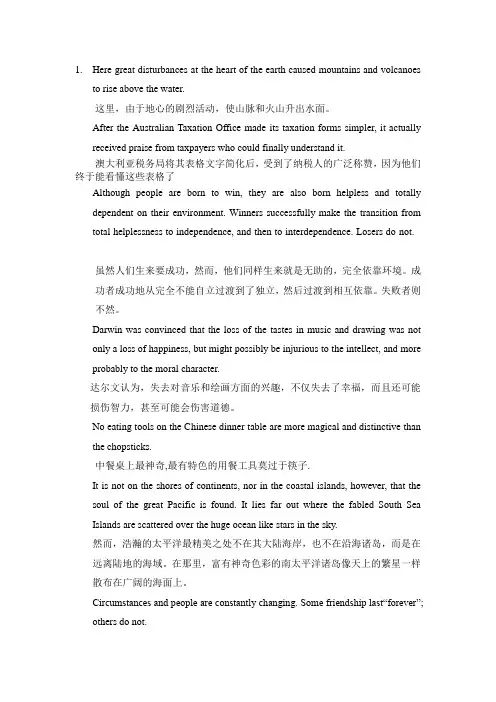
1.Here great disturbances at the heart of the earth caused mountains and volcanoesto rise above the water.这里,由于地心的剧烈活动,使山脉和火山升出水面。
After the Australian Taxation Office made its taxation forms simpler, it actually received praise from taxpayers who could finally understand it.澳大利亚税务局将其表格文字简化后,受到了纳税人的广泛称赞,因为他们终于能看懂这些表格了Although people are born to win, they are also born helpless and totally dependent on their environment. Winners successfully make the transition from total helplessness to independence, and then to interdependence. Losers do not.虽然人们生来要成功,然而,他们同样生来就是无助的,完全依靠环境。
成功者成功地从完全不能自立过渡到了独立,然后过渡到相互依靠。
失败者则不然。
Darwin was convinced that the loss of the tastes in music and drawing was not only a loss of happiness, but might possibly be injurious to the intellect, and more probably to the moral character.达尔文认为,失去对音乐和绘画方面的兴趣,不仅失去了幸福,而且还可能损伤智力,甚至可能会伤害道德。
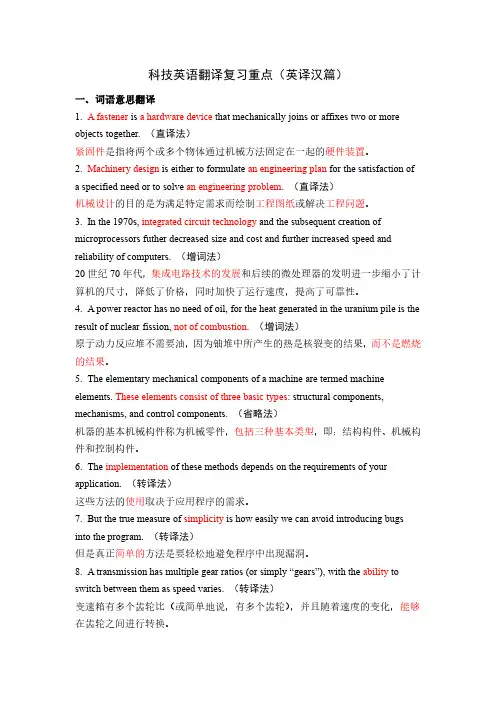
科技英语翻译复习重点(英译汉篇)一、词语意思翻译1.A fastener is a hardware device that mechanically joins or affixes two or more objects together.(直译法)紧固件是指将两个或多个物体通过机械方法固定在一起的硬件装置。
2.Machinery design is either to formulate an engineering plan for the satisfaction ofa specified need or to solve an engineering problem.(直译法)机械设计的目的是为满足特定需求而绘制工程图纸或解决工程问题。
3.In the1970s,integrated circuit technology and the subsequent creation of microprocessors futher decreased size and cost and further increased speed and reliability of computers.(增词法)20世纪70年代,集成电路技术的发展和后续的微处理器的发明进一步缩小了计算机的尺寸,降低了价格,同时加快了运行速度,提高了可靠性。
4.A power reactor has no need of oil,for the heat generated in the uranium pile is the result of nuclear fission,not of combustion.(增词法)原子动力反应堆不需要油,因为铀堆中所产生的热是核裂变的结果,而不是燃烧的结果。
5.The elementary mechanical components of a machine are termed machine elements.These elements consist of three basic types:structural components, mechanisms,and control components.(省略法)机器的基本机械构件称为机械零件,包括三种基本类型,即:结构构件、机械构件和控制构件。
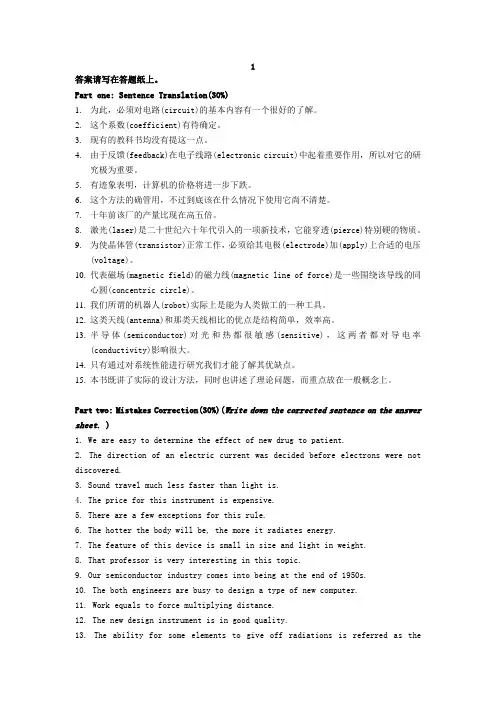
1答案请写在答题纸上。
Part one: Sentence Translation(30%)1.为此,必须对电路(circuit)的基本内容有一个很好的了解。
2.这个系数(coefficient)有待确定。
3.现有的教科书均没有提这一点。
4.由于反馈(feedback)在电子线路(electronic circuit)中起着重要作用,所以对它的研究极为重要。
5.有迹象表明,计算机的价格将进一步下跌。
6.这个方法的确管用,不过到底该在什么情况下使用它尚不清楚。
7.十年前该厂的产量比现在高五倍。
8.激光(laser)是二十世纪六十年代引入的一项新技术,它能穿透(pierce)特别硬的物质。
9.为使晶体管(transistor)正常工作,必须给其电极(electrode)加(apply)上合适的电压(voltage)。
10.代表磁场(magnetic field)的磁力线(magnetic line of force)是一些围绕该导线的同心圆(concentric circle)。
11.我们所谓的机器人(robot)实际上是能为人类做工的一种工具。
12.这类天线(antenna)和那类天线相比的优点是结构简单,效率高。
13.半导体(semiconductor)对光和热都很敏感(sensitive),这两者都对导电率(conductivity)影响很大。
14.只有通过对系统性能进行研究我们才能了解其优缺点。
15.本书既讲了实际的设计方法,同时也讲述了理论问题,而重点放在一般概念上。
Part two: Mistakes Correction(30%)(Write down the corrected sentence on the answer sheet. )1. We are easy to determine the effect of new drug to patient.2. The direction of an electric current was decided before electrons were not discovered.3. Sound travel much less faster than light is.4. The price for this instrument is expensive.5. There are a few exceptions for this rule.6. The hotter the body will be, the more it radiates energy.7. The feature of this device is small in size and light in weight.8. That professor is very interesting in this topic.9. Our semiconductor industry comes into being at the end of 1950s.10. The both engineers are busy to design a type of new computer.11. Work equals to force multiplying distance.12. The new design instrument is in good quality.13. The ability for some elements to give off radiations is referred as theradioactivity.Part three:Read this article, translate the underlined sentences(15%), answer the questions (15%)and then summarize this article within 100 words (10%).The Dazzle of Lasers(激光)The acronym(首字母缩写词)"laser," describes how the device works: Light Amplification by Stimulated Emission of Radiation. In 1916 Einstein predicted that electrons(电子) in an atom could be deliberately stimulated to emit photons(光子) (light energy) of a certain wavelength. He was right. The laser must first be "pumped" with energy in a variety of ways so that the electrons are excited into higher energy states. But these high energy electrons are unstable--and fall back to a lower energy level. On the way down, their extra energy is released(释放)as light. That light is captured inside the laser and amplified by bouncing it back and forth between mirrors. The laser beam that emerges is amplified, monochromatic (单色的), coherent light --and it shines with an unearthly power.Not until 1960 did Theodore Maiman, a 33-year-old engineer at Hughes Research Laboratories, build a homely four-inch cylinder containing a ruby rod encircled by a flash tube: the world's first working laser.More than two decades later, the laser has wrought a technological revolution. Lasers are an indispensable tool for delicate eye surgery, and doctors are using lasers experimentally to destroy cancerous tumors(肿瘤), unclog(使畅通) diseased arteries (动脉) and even treat herpes(疱疹). Just as they provide new tools for health care, however, they also make possible new engines of destruction: recently Dr. Edward Teller, the father of the hydrogen bomb(氢弹), called on President Reagon to urge that the United States build a space-based laser-weapon system that would use a nuclear bomb to fire brutally intense laser X-rays against enemy missiles in flight.Today pilots flying the new Boeing 767 and 757 aircraft navigate with the aid of new laser gyroscopes(陀螺仪). Supermarket clerks use lasers to ring up prices at the checkout counter by "reading" universal bar-codes(条形码) printed on packages and canned goods. Powerful lasers cut and weld(焊) steel in factories from Detroit to Tokyo. Artists and filmmakers are beginning to use lasers for animation(动画): at Lucasfilm, George Lucas has a team of computer wizards(奇才) developing a machinethat uses a computer-driven laser to draw animated images on film; a second film, with human actors, is then merged by laser with the graphics into a single seamless (无缝的) whole.How does the laser work? Anyone who has ever focused sunlight through a magnifying glass and watched paper or dry leaves snap into flames understands the power of concentrated light. Laser light is intense, concentrated light, too, but it works on a different principle. Shine sunlight through a prism(棱镜) and it breaks into the glorious colors of the rainbow. In the scientists' vocabulary, sunlight is "incoherent" --it is made up of a mix of wavelengths spanning the spectrum(光谱)from infrared(红外线) to ultraviolet(紫外线). Laser light, on the other hand, is monochromatic and coherent-it shines at a single wavelength, and all the light waves march together in step like soldiers on parade(游行).In the two decades since its invention, the laser has undergone a dramatic transformation: a wide variety of gas, solid-state, diode(二极管) and other lasers has been created. Each shines at a different wavelength; some pulse on and off, others operate continuously.When the laser moved out of the laboratory, one of its first and most significant applications was as a medical tool. Lasers are commonly used for delicate surgery inside the eye. In treating blood-vessel disorders resulting from complications(并发症) of diabetes(糖尿病), doctors aim a fine beam of argon laser light(氩激光) through the pupil(瞳孔) of the eye and place up to 2000 tiny laser burns very closely around the back portion of the retina(视网膜). These laser "welds" prevent harmful growth or rupture(断裂) of new, unwanted blood vessels.The very properties that make lasers dangerous --power and heat--are also being put to use to destroy some kinds of brain and spinal(脊髓的) tumors. Lasers have brought a new frontier to neurosurgery(神经外科). They have made some inoperable tumors operable and high-risk tumors less high risk.Warfare is also changing as laser technology advances. Laser guidance systems have brought once unimaginable accuracy to artillery(炮). In the near future, higher-intensity lasers may be used to blind the electronic sensory systems of aircraft, missiles, tanks and ships. And ultimately, some visionaries insists, the globe could be surrounded by a platoon(排) of orbiting battle stations armed with lasers capable of destroying planes and missiles within seconds of their beinglaunched.Just as they are opening new doors to medicine and military practices, lasers are also having a profound impact on communications. Instead of sunbeams, today's light-wave communication systems use laser light ricocheting through tiny glass fibers. Lasers generate light waves at extraordinarily high frequencies--in the range of trillions of cycles per second --which makes it possible to transmit enormous quantities of information. In addition, fiber-optic cables are cheaper than copper wire and are not subject to electromagnetic interference, or the annoying cross talk(串话) and static that plague(折磨) current systems. The big breakthrough was the semiconductor laser.Someday laser light may be piped through giant optic cables into deep ocean waters to create undersea farms; it may be beamed into space to talk to orbiting space stations. Lasers also may be used to fire extremely precise light pulses at DNA molecules, altering the structure of chromosomes(染色体) and thereby repairing defective genes --or even creating new forms of life. And eventually billions of lasers will link the world in a vast information network, a global village of light.1.How does the laser work?2.What is the difference between sunlight and the laser?3.Is the laser absolutely safe? If not, please explain.4.What are the advantages of the semiconductor laser in the communications field?5.In what fields is the laser applied?Part one:1.For this purpose, it is necessary to have a good understanding of the fundamentals of thecircuit.2.This coefficient remains to be determined.3.None of the textbook available mentions this point.4.Since feedback plays an important role in the electronic circuit, its study is very important.5.There is an indication that the price of computers will fall further.6.This method does work, but it is not clear in what condition it is that it should be used.7.The output of this factory 10 years ago is 6 times what it is now.8. A new technology introduced in the 1960s, laser can pierce very hard substances.9.For the transistor to work normally, it is necessary to apply a proper voltage across theelectrode.10.The magnetic lines of force representing the magnetic field are some concentric circlessurrounding the wire.11.What is called a robot is a tool which can do work for the human being.12.This type of antenna has the advantages over that one of simple structure and high efficiency.13.Semiconductors are sensitive to light and hear, both of which have a great impact onconductivity.14.Only through a study of the system’s performance is it possible to know its advantages anddisadvantages.15.This book discusses both practical design method and theoretical problems with emphasis onthe basic concept.Part two:1.It is easy to determine the effect of the new drug on the patient.2.The direction of the electric current had been decided before electrons were discovered.3.Sound travels much more slowly that light does.4.This instrument is expensive.5.There are a few exceptions to this rule.6.The hotter the body is, the more energy it radiates.7.This device is small and light.8.That professor is much interested in this topic.9.Our semiconductor industry came into being at the end of the 1950s.10.Both the engineers are busy designing a new type of computer.11.Work equals force multiplied by distance.12.The newly designed instrument is good in quality.13.The ability of some elements ot give off radiations is referred as the radioactivity.Part three:Translation:1. 20多年前,激光引发了一场技术革命。
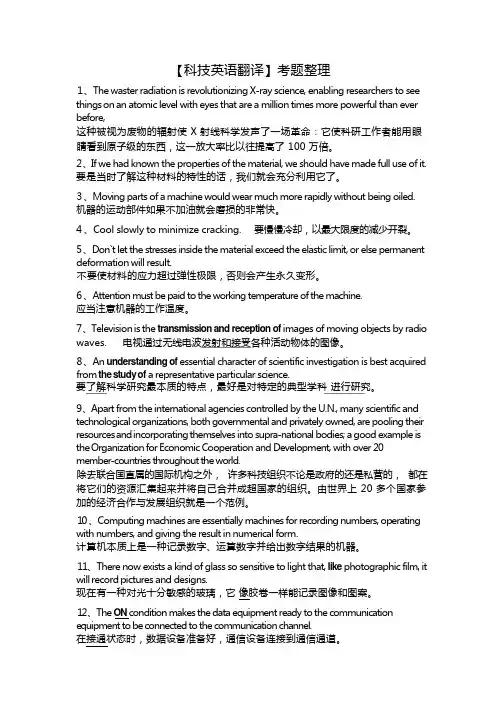
【科技英语翻译】考题整理1、The waster radiation is revolutionizing X-ray science, enabling researchers to see things on an atomic level with eyes that are a million times more powerful than ever before,这种被视为废物的辐射使 X 射线科学发声了一场革命:它使科研工作者能用眼睛看到原子级的东西,这一放大率比以往提高了 100 万倍。
2、If we had known the properties of the material, we should have made full use of it. 要是当时了解这种材料的特性的话,我们就会充分利用它了。
3 、Moving parts of a machine would wear much more rapidly without being oiled. 机器的运动部件如果不加油就会磨损的非常快。
4 、Cool slowly to minimize cracking. 要慢慢冷却,以最大限度的减少开裂。
5、Don`t let the stresses inside the material exceed the elastic limit, or else permanent deformation will result.不要使材料的应力超过弹性极限,否则会产生永久变形。
6 、Attention must be paid to the working temperature of the machine.应当注意机器的工作温度。
7 、Television is the transmission and reception of images of moving objects by radio waves. 电视通过无线电波发射和接受各种活动物体的图像。
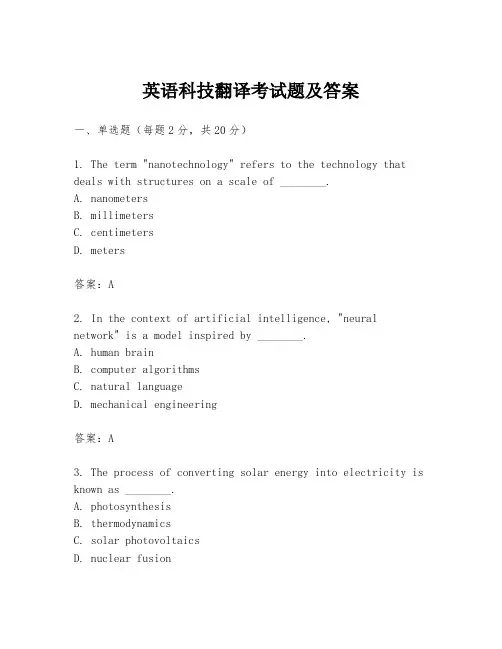
英语科技翻译考试题及答案一、单选题(每题2分,共20分)1. The term "nanotechnology" refers to the technology that deals with structures on a scale of ________.A. nanometersB. millimetersC. centimetersD. meters答案:A2. In the context of artificial intelligence, "neural network" is a model inspired by ________.A. human brainB. computer algorithmsC. natural languageD. mechanical engineering答案:A3. The process of converting solar energy into electricity is known as ________.A. photosynthesisB. thermodynamicsC. solar photovoltaicsD. nuclear fusion答案:C4. Which of the following is not a characteristic of a quantum computer?A. SuperpositionB. EntanglementC. DeterministicD. Quantum tunneling答案:C5. The term "biotechnology" is often associated with the manipulation of ________.A. electronic devicesB. living organismsC. chemical compoundsD. geological formations答案:B6. In the field of robotics, "actuator" refers to a component that ________.A. senses the environmentB. processes informationC. moves or controls a mechanismD. stores energy答案:C7. "Internet of Things" (IoT) involves the interconnection of everyday objects, enabling them to send and receive data,which is based on ________.A. cloud computingB. artificial intelligenceC. machine learningD. traditional networking答案:A8. The abbreviation "AI" stands for ________.A. Artificial IntelligenceB. Artificial InputC. Advanced InterfaceD. Automated Interaction答案:A9. "Genetic engineering" involves the ________ of an organism's genes.A. removalB. additionC. modificationD. replication答案:C10. "Cybersecurity" is concerned with protecting ________.A. physical infrastructureB. digital informationC. environmental resourcesD. financial assets答案:B二、填空题(每题2分,共20分)1. The smallest unit of data in computing is called a________.答案:bit2. A ________ is a type of computer system designed to recognize, interpret, and simulate human actions.答案:robot3. In computer science, "algorithm" refers to a well-defined procedure that produces an answer to a ________.答案:problem4. The study of the behavior and interactions of dispersed phase(s) in a fluid medium is known as ________.答案:fluid mechanics5. A ________ is a device that uses light to transmit information.答案:fiber optic6. The process of converting data into a format that can be easily shared or analyzed is called ________.答案:data mining7. "Virtual reality" is a computer-generated simulation of a ________ environment.答案:three-dimensional8. The ________ is a set of rules that defines how data is formatted, transmitted, received, and processed.答案:protocol9. A ________ is a type of computer program that canreplicate itself and often spread to other computers.答案:virus10. "Machine learning" is a subset of artificial intelligence that allows computers to learn from and make decisions based on ________.答案:data三、阅读理解题(每题5分,共30分)阅读以下段落,并回答问题。
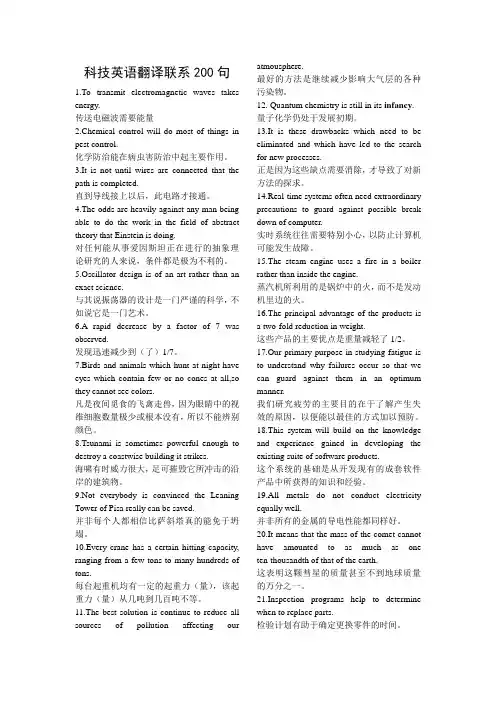
科技英语翻译联系200句1.To transmit electromagnetic waves takes energy.传送电磁波需要能量2.Chemical control will do most of things in pest control.化学防治能在病虫害防治中起主要作用。
3.It is not until wires are connected that the path is completed.直到导线接上以后,此电路才接通。
4.The odds are heavily against any man being able to do the work in the field of abstract theory that Einstein is doing.对任何能从事爱因斯坦正在进行的抽象理论研究的人来说,条件都是极为不利的。
5.Oscillator design is of an art rather than an exact science.与其说振荡器的设计是一门严谨的科学,不如说它是一门艺术。
6.A rapid decrease by a factor of 7 was observed.发现迅速减少到(了)1/7。
7.Birds and animals which hunt at night have eyes which contain few or no cones at all,so they cannot see colors.凡是夜间觅食的飞禽走兽,因为眼睛中的视维细胞数量极少或根本没有,所以不能辨别颜色。
8.Tsunami is sometimes powerful enough to destroy a coastwise building it strikes.海啸有时威力很大,足可摧毁它所冲击的沿岸的建筑物。
9.Not everybody is convinced the Leaning Tower of Pisa really can be saved.并非每个人都相信比萨斜塔真的能免于坍塌。
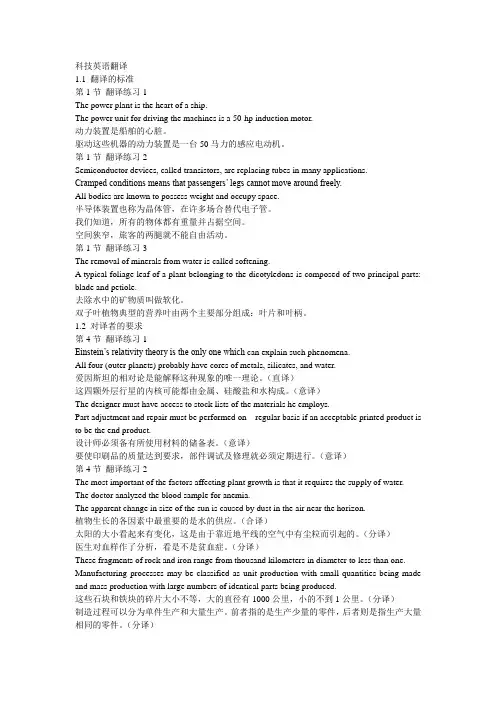
科技英语翻译1.1 翻译的标准第1节翻译练习1The power plant is the heart of a ship.The power unit for driving the machines is a 50-hp induction motor.动力装置是船舶的心脏。
驱动这些机器的动力装置是一台50马力的感应电动机。
第1节翻译练习2Semiconductor devices, called transistors, are replacing tubes in many applications.Cramped conditions means that passengers’ legs cannot move around freely.All bodies are known to possess weight and occupy space.半导体装置也称为晶体管,在许多场合替代电子管。
我们知道,所有的物体都有重量并占据空间。
空间狭窄,旅客的两腿就不能自由活动。
第1节翻译练习3The removal of minerals from water is called softening.A typical foliage leaf of a plant belonging to the dicotyledons is composed of two principal parts: blade and petiole.去除水中的矿物质叫做软化。
双子叶植物典型的营养叶由两个主要部分组成:叶片和叶柄。
1.2 对译者的要求第4节翻译练习1Einstein’s relativity theory is the only one which can explain such phenomena.All four (outer planets) probably have cores of metals, silicates, and water.爱因斯坦的相对论是能解释这种现象的唯一理论。
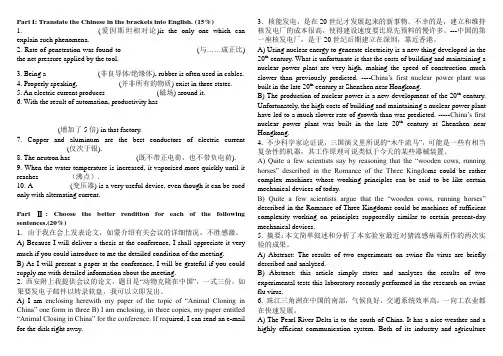
Part I: Translate the Chinese in the brackets into English. (15%)1. ____________________(爱因斯坦相对论)is the only one which can explain such phenomena.2. Rate of penetration was found to ____________________ (与……成正比) the net pressure applied by the tool.3. Being a ______________(非良导体/绝缘体), rubber is often used in cables.4. Properly speaking, ___________(并非所有的物质) exist in three states.5. An electric current produces ______________(磁场) around it.6. With the result of automation, productivity has ______________ (增加了5倍) in that factory.7. Copper and aluminum are the best conductors of electric current ______________(仅次于银).8. The neutron has __________________(既不带正电荷,也不带负电荷).9. When the water temperature is increased, it vaporized more quickly until it reaches ________(沸点).10. A __________(变压器) is a very useful device, even though it can be sued only with alternating current.Part Ⅱ: Choose the better rendition for each of the following sentences.(20%)1.由于我在会上发表论文,如蒙介绍有关会议的详细情况,不胜感激。
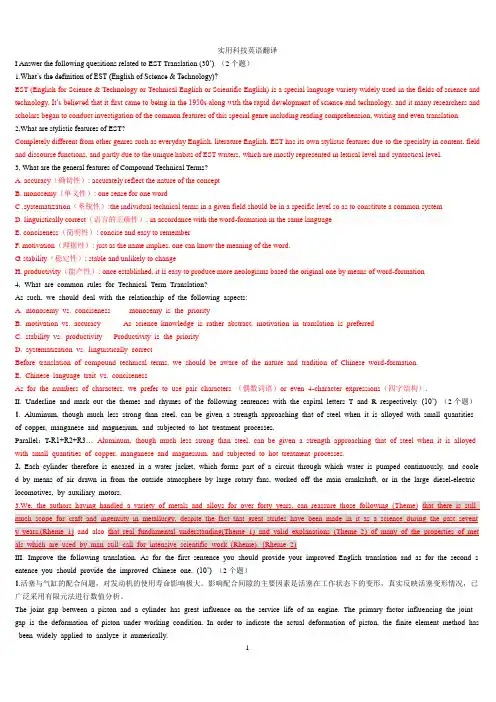
实用科技英语翻译I Answer the following quesitions related to EST Translation (30’)(2个题)1.What’s the definition of EST (English of Science & Technology)?EST (English for Science & Technology or Technical English or Scientific English) is a special language variety widely used in the fields of science and technology. It’s believed that it first came to being in the 1950s along with the rapid development of science and technology, and it many researchers and scholars began to conduct investigation of the common features of this special genre including reading comprehension, writing and even translation.2,What are stylistic features of EST?Completely different from other genres such as everyday English, literature English, EST has its own stylistic features due to the specialty in content, field and discourse functions, and partly due to the unique habits of EST writers, which are mostly represented in lexical level and syntactical level.3, What are the general features of Compound Technical Terms?A. accuracy(确切性): accurately reflect the nature of the conceptB. monosemy(单义性): one sense for one wordC .systematization(系统性):the individual technical terms in a given field should be in a specific level so as to constitute a common systemD. linguistically correct(语言的正确性): in accordance with the word-formation in the same languageE. conciseness(简明性): concise and easy to rememberF. motivation(理据性): just as the name implies, one can know the meaning of the word.G. stability(稳定性): stable and unlikely to changeH. productivity(能产性): once established, it is easy to produce more neologisms based the original one by means of word-formation4, What are common rules for Technical Term Translation?As such, we should deal with the relationship of the following aspects:A. monosemy vs. conciseness monosemy is the priorityB. motivation vs. accuracy As science knowledge is rather abstract, motivation in translation is preferredC. stability vs. productivity Productivity is the priorityD. systematization vs. linguistically correctBefore translation of compound technical terms, we should be aware of the nature and tradition of Chinese word-formation.E. Chinese language trait vs. concisenessAs for the numbers of characters, we prefer to use pair characters (偶数词语)or even 4-character expressions(四字结构).II. Underline and mark out the themes and rhymes of the following sentences with the capital letters T and R respectively. (10’)(2个题)1. Aluminum, though much less strong than steel, can be given a strength approaching that of steel when it is alloyed with small quantities of copper, manganese and magnesium, and subjected to hot treatment processes.Parallel:T-R1+R2+R3…Aluminum, though much less strong than steel, can be given a strength approaching that of steel when it is alloyed with small quantities of copper, manganese and magnesium, and subjected to hot treatment processes.2. Each cylinder therefore is encased in a water jacket, which forms part of a circuit through which water is pumped continuously, and cooled by means of air drawn in from the outside atmosphere by large rotary fans, worked off the main crankshaft, or in the large diesel-electric locomotives, by auxiliary motors.3.We, the authors having handled a variety of metals and alloys for over forty years, can reassure those following (Theme)andIII. Improve the following translation. As for the first sentence you should provide your improved English translation and as for the second s entence you should provide the improved Chinese one. (10’)(2个题)1.活塞与气缸的配合问题,对发动机的使用寿命影响极大。
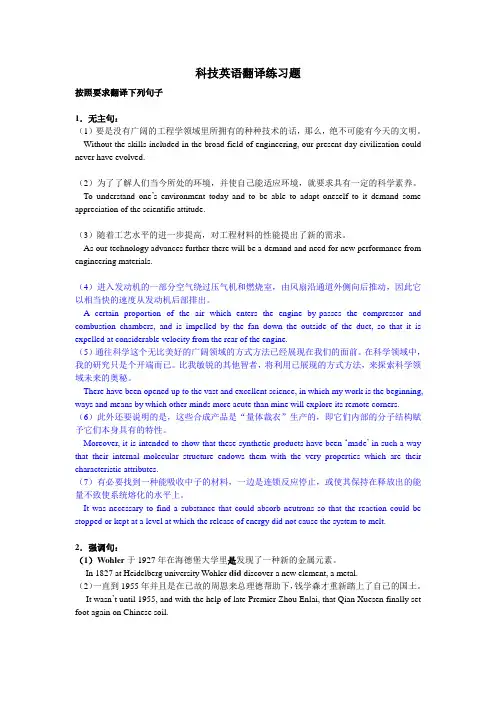
科技英语翻译练习题按照要求翻译下列句子1.无主句:(1)要是没有广阔的工程学领域里所拥有的种种技术的话,那么,绝不可能有今天的文明。
---Without the skills included in the broad field of engineering, our present-day civilization could never have evolved.(2)为了了解人们当今所处的环境,并使自己能适应环境,就要求具有一定的科学素养。
---To understand one‟s environment today and to be able to adapt oneself to it demand some appreciation of the scientific attitude.(3)随着工艺水平的进一步提高,对工程材料的性能提出了新的需求。
---As our technology advances further there will be a demand and need for new performance from engineering materials.(4)进入发动机的一部分空气绕过压气机和燃烧室,由风扇沿通道外侧向后推动,因此它以相当快的速度从发动机后部排出。
---A certain proportion of the air which enters the engine by-passes the compressor and combustion chambers, and is impelled by the fan down the outside of the duct, so that it is expelled at considerable velocity from the rear of the engine.(5)通往科学这个无比美好的广阔领域的方式方法已经展现在我们的面前。
科技英语翻译总复习答案总复习题(3~7章)第三章1. Other factors affect the configuration of the total system其他因素影响整个系统的结构2. In normal flight the hatch doors fair into the fuselage正常飞行时,舱门与机身平整贴合3. Energy can neither be created ,nor destroyed by any means known to man 用人们已知的方法,既不能创造能量也不能消灭能量4. It is customary to refer to design levels as high or low on component complexity 习惯上根据部件的复杂程度把设计级称作高设计级或低设计级5. The main economy of the system stems from the ability to move cars in a continues train without uncoupling此系统的主要经济之处在于它能够移动列车的车厢而不必将他们脱钩分开6. He is a stranger to the operation of the electronic computer他对于电子计算机的操作是陌生的7. A key element in system capacity planning is the financial cost of performance 系统能力计划中的关键因素是性能的经济成本8 The assembler can expand the key words in the assembly code into their full instruction set这种汇编程序能把汇编代码中的关键字扩展成完整的指令集9 The flame does not touch the flask directly烧瓶没有直接接触火焰10. The study of the strength of solids involves the study of the defects in the crystalline structure研究固体强度,就必须研究晶体结构中的缺陷11. The problem was solved by the provision of a compensation jet通过安装一个补偿喷头,解决了这个问题12 The rusting of iron is the slow chemical combination of the elements iron and oxygen in moist atmosphere铁元素生锈是铁元素和氧元素在湿空气中缓慢化合的现象13. The decay or organic matter is a slow oxidation by oxygen in the air 有机物的腐烂是空气中氧引起的一种缓慢氧化过程14. In order to improve a certain kind of battery , Edison spent almost ten years and made nearly 50000 experiments为了改善一种电池的性能,爱迪生花了差不多十年时间,做了近50000次试验第四章1. The rise in temperature could not have happened of itself温度上升不可能是出于自身的原因2. Be the shape of a baby complicated, it is possible to find outits volume 不论物体的形状如何复杂,人们均可求出它的体积3.The more energy we desire to send, the higher we make the voltage 要求输送的电能越多,就得使电压升的越高4.The most typical humanlike characteristic of a robot is its arm 机器人最具人性化的特点是它的机械臂5. In our studies of the implications for the First Law, we were able to see the importance 我们研究第一定律时,可以明白区分状态函数和路径函数的重要性。
【科技英语翻译】考题整理1、The waster radiation is revolutionizing X-ray science, enabling researchers to see things on an atomic level with eyes that are a million times more powerful than ever before,这种被视为废物的辐射使X射线科学发声了一场革命:它使科研工作者能用眼睛看到原子级的东西,这一放大率比以往提高了100万倍。
2、If we had known the properties of the material, we should have made full use of it. 要是当时了解这种材料的特性的话,我们就会充分利用它了。
3、Moving parts of a machine would wear much more rapidly without being oiled.机器的运动部件如果不加油就会磨损的非常快。
4、Cool slowly to minimize cracking. 要慢慢冷却,以最大限度的减少开裂。
5、Don`t let the stresses inside the material exceed the elastic limit, or else permanent deformation will result.不要使材料的应力超过弹性极限,否则会产生永久变形。
6、Attention must be paid to the working temperature of the machine.应当注意机器的工作温度。
7、Television is the transmission and reception of images of moving objects by radio waves. 电视通过无线电波发射和接受各种活动物体的图像。
科技英语翻译总复习答案科技英语翻译总复习答案总复习题(3~7章)第三章1. Other factors affect the configuration of the total system其他因素影响整个系统的结构2. In normal flight the hatch doors fair into the fuselage正常飞行时,舱门与机身平整贴合3. Energy can neither be created ,nor destroyed by any means known to man 用人们已知的方法,既不能创造能量也不能消灭能量4. It is customary to refer to design levels as high or low on component complexity 习惯上根据部件的复杂程度把设计级称作高设计级或低设计级5. The main economy of the system stems from the ability to move cars in a continues train without uncoupling此系统的主要经济之处在于它能够移动列车的车厢而不必将他们脱钩分开6. He is a stranger to the operation of the electronic computer他对于电子计算机的操作是陌生的7. A key element in system capacity planning is the financial cost of performance 系统能力计划中的关键因素是性能的经济成本8 The assembler can expand the key words in the assembly code into their full instruction set这种汇编程序能把汇编代码中的关键字扩展成完整的指令集9 The flame does not touch the flask directly烧瓶没有直接接触火焰10. The study of the strength of solids involves the study ofthe defects in the crystalline structure研究固体强度,就必须研究晶体结构中的缺陷11. The problem was solved by the provision of a compensation jet通过安装一个补偿喷头,解决了这个问题12 The rusting of iron is the slow chemical combination of the elements iron and oxygen in moist atmosphere铁元素生锈是铁元素和氧元素在湿空气中缓慢化合的现象13. The decay or organic matter is a slow oxidation by oxygen in the air 有机物的腐烂是空气中氧引起的一种缓慢氧化过程14. In order to improve a certain kind of battery , Edison spent almost ten years and made nearly 50000 experiments 为了改善一种电池的性能,爱迪生花了差不多十年时间,做了近50000次试验第四章1. The rise in temperature could not have happened of itself温度上升不可能是出于自身的原因2. Be the shape of a baby complicated, it is possible to find outits volume 不论物体的形状如何复杂,人们均可求出它的体积3.The more energy we desire to send, the higher we make the voltage 要求输送的电能越多,就得使电压升的越高4.The most typical humanlike characteristic of a robot is its arm 机器人最具人性化的特点是它的机械臂5. In our studies of the implications for the First Law, we were able to see the importance 我们研究第一定律时,可以明白区分状态函数和路径函数的重要性。
西安电子科技大学网络教育学院模拟试题(一)《科技英语》期末考试试题(考试形式120 分钟)题号一二三四五总分题分得分I. Put the following sentences into Chinese: (4 points for each)1. The current reaches the maximum value when w = w 0 , similar to the situation ina series resonant circuit.2. With the switch on position 1, the output impedance will be maximum.3. The greater the nuclear mass, the less of the neutron's energy is transferred to the nucleus.4. XVI is used to express the number of 16. To express a number a thousand times larger, the Romans put a line above that number.5. In this case the signal waveform can be transmitted undistorted.6. A capacitor is a device consisting of two conductors separated by a non-conductor.7. Expressed in a formula, the relationship between voltage, current, and resistance can be written as V = IR.8. This account for the observation that the resistivity of a metal increases with temperature.9. While there has been an enormous amount of literature about ATM over the past two years, many networking books have not focused on ATM itself.10. The advantage of TDMA over SCPC is that more ground stations can share a single satellite transponder.11. In 1895, a German physicist discovered what are known as X rays.12. The material of which this conductor is made is copper.13. It is when an object is heated that the average speed of molecules is increased.14. Only when we exert on an object an upward force sufficient in magnitude can we lift it.15. In every atom in its normal state, the number of protons equals the number of electrons, something that is directly related to the electrical properties of the proton and the electron.II. Translate the following into Chinese: (40 points in all)A computer is a machine and, like all machines, must be directed and controlled to perform a task. Until a program is prepared and stored in the computer's memory, the computer "knows" absolutely nothing, not even how to accept data. No matter how good a computer may be, it must be "told" what to do. The utility of a computer cannot be fully realized, therefore, until the capabilities (and the limitations) of the computer are recognized:1. Repetitive operation: a computer can perform similar operations thousands of times, without becoming bored, tired, or careless.2. Speed: a computer processes information at extremely rapid rates. For example, modern computers can solve certain classes of problems millions of times faster than a skilled mathematician.3. Flexibility: general-purpose computers may be programmed to solve many types of problems.4. Accuracy: computers may be programmed to calculate answers with a desired level of accuracy as specified by the programmer.5. Intuition: a computer has no intuition. A man may suddenly find the answers to a problem without working out the details, but a computer can only proceed as ordered. In examining any computer system, there are three levels at which it is useful to consider the candidate machine: the architectural level, the organizational level and the implementation level. The architecture of a computer is often defined as the set of resources seen by the programmer. At the organizational level, one views of the computer system beneath the visible architectural level. At the implementation level, we view the computer system as a collection of wires, cables, semiconductor chips and discrete components.西安电子科技大学网络教育学院模拟试题(二)《科技英语》期末考试试题(考试形式120 分钟)题号一二三四五总分题分得分I. Put the following sentences into Chinese: (4 points for each)•The varieties of nonferrous( 有色金属) metal are nearly four times what they were.2. Faraday was unable to calculate the velocity of propagation of electromagnetic waves, a task which required the mathematical precision of Maxwell, which Faraday entirely lacked.3. The wave theory can give no reason why there should be a threshold frequency below which no photoelectrons are observed, no matter how strong the light beam, something that follows naturally form the quantum theory.4. The first step in a nuclear reaction between two colliding nuclear particles is their joining together to form a compound nucleus.5. A further complication is the tendency of the pilot's blood to leave his head because of inertia, leaving him impaired vision and perhaps unconscious.6. Discussion of this material is deferred until the final chapter because only then is the feedback, circuit, and application background necessary to fully appreciate the subtleties of compensating modem operational amplifiers available.7. Of wider application is the fact that matter usually expands when its temperature is increased and contracts when its temperature is decreased.8. The greater the nuclear mass, the less of the neutron's energy is transferred to the nucleus.9. The turning of the earth on its own axis is what makes the change from day to night.10. It is the existence of and the ability to control precisely these two independent charge-transport mechanisms that make possible all junction semiconductor devices.11. A new technology introduced in the 1960s, laser can pierce the hardest substance such as diamond.12. This is so sensitive an ammeter that it can measure the slight change in current. •Light, durable, simple and inexpensive , such devices are warmly received by users.•The question now arises whether this series converges.•Feedback plays an important role in almost all electronic circuits. Its study is introduced here to provide a view of the amplifier as a gain element.II. Translate the following into Chinese: (40 points in all)Modern civilization would be impossible without the use of large quantities of energy. In the last forty years, energy usage in the United States has increased more than400% while the accompanying population increase has been only 72%. Thus the per capita use of energy in the United States has increased at a very fast rate.Until recently, the world's energy demands were met almost entirely through the use of fossil fuels: wood, coal, petroleum, and natural gas. Since these are limited in quantity, however, other sources must be found. Nuclear and solar energy are two alternate sources, and neither of them is limited. It has been calculated, for instance, that the energy demands of the whole world could be met by utilizing the solar energy falling on a 12 5-mile square plot of ground near the equator. At the present time, however, nuclear and solar energy make up only a small fraction of the total energy used. As our knowledge and means of converting these ample energy supplies into usable forms increase, we shall be better able to keep pace with rising energy needs. However, it will take more than just the efforts' of science to solve the energy problem. Fuel conservation by all segments of the population must accompany new scientific advances.Briefly stated, science is the search for relationships that explain and predict the behavior of the universe. Technology is the application of these relationships to our needs and goals. Finding new energy sources falls into the realm of science. Developing and utilizing these discoveries are matters of technology.The complementary work of scientists and technologists is also referred to, respectively, as research and development. Both government and private industry allocate large sums of money to support the research and development activities of scientists and engineers. Without such support, there would be little improvement in the processes, products, and services that are derived from these activities.西安电子科技大学网络教育学院模拟试题(三)《科技英语》期末考试试题(考试形式120 分钟)题号一二三四五总分题分得分I . Put the following sentences into Chinese: (4 points for each)1. It is important for the reader to learn and understand the basic concepts and operations presented here, or the development and the applications of later topics will be difficult to comprehend.2. The capacitance of a capacitor depends on the size of the plates and their distance apart.3. Large or small , all circuits will contain the same kinds of components.4. A baseball that lands in an open soon comes to rest because of its interaction with the ground.5. The effect of temperature on the resistance of a semiconductor must be taken into account.6. These layers are not “stretched” as a rubber sheet would be.7. Full use must be made of the computers available.8. Gravity is the tendency of all objects to attract, and be attracted by, each other.9. Having studied this chapter, the reader will understand the principles of a radio receiver.10. Each planet revolves around the sun in an elliptical orbit, with the sun at one focus of the ellipse .11. The line of action is a line of infinite length, of which the force vector is a segment.12. As pointed out in the last chapter, the emf of a battery is generated by the chemical reaction within it.13. It is when an object is heated that the average speed of molecules is increased.14. We call insulators these substances which prevent the passage of electricity.15. What lies behind this meeting is an increasing awareness around the world of the urgency of reducing global warming.II. Translate the following into Chinese: (40 points in all)A computer, like any other machine, is used because it does certain tasks better and more efficiently than humans. Specifically, it can receive more information and process it faster than a human. Often, this speed means that weeks or months of pencil-and-paper work can be replaced by a method requiring only minutes of computer time. Therefore, computers are used when the time saved by using a computer offsets its cost. Further, because of its capacity to handle large volumes of data in a very short time, a computer may be the only means of resolving problems when time is limited. Because of the advantages of great speed and large capacity, computers are being used extensively in business, industry, and research. Most computer applications can be classified as either business (or data base related ) uses, which usually rely upon the computer's capacity to store and quickly retrieve large amounts of information, or scientific uses, which require accuracy and speed in performing mathematical calculations. Both of these are performed ongeneral-purpose computers. We shall now describe a few examples of computer applications.Design problems The computer is a very useful calculating tool for the design engineer. The wing design of a supersonic aircraft, for example, depends upon many factors. The designer describes each of these factors in the form of mathematical equations specified in a programming language. The computer can then be used to solve these equations for arbitrary input data.Scientific and laboratory experiments In scientific and laboratory experiments, computers are used to evaluate, store and process information from numerous types of electronic sensing devices. Computers are particularly useful in such systems as telemetry, where signals must be quickly recorded or be lost. Such applications require rapid and accurate processing for both fixed conditions and dynamic situations.模拟试题一Part I1 当 w = w 0 时,电流达到最大值,这和串连谐振电路的情况相似。
考试日期:05 年12 月31 日1.为此,必须对电路(circuit)的基本内容有一个很好的了解。
For this purpose, it is necessary to have a good understanding of the fundamentals of the circuit.2.这个系数(coefficient)有待确定。
This coefficient remains to be determined.3.现有的教科书均没有提这一点。
None of the textbook available mentions this point.4.由于反馈(feedback)在电子线路(electronic circuit)中起着重要作用,所以对它的研究极为重要。
Since feedback plays an important role in the electronic circuit, its study is very important.5.有迹象表明,计算机的价格将进一步下跌。
There is an indication that the price of computers will fall further.6.这个方法的确管用,不过到底该在什么情况下使用它尚不清楚。
This method does work, but it is not clear in what condition it is that it should be used.7.十年前该厂的产量比现在高五倍。
The output of this factory 10 years ago is 6 times what it is now.8.激光(laser)是二十世纪六十年代引入的一项新技术,它能穿透(pierce)特别硬的物质。
A new technology introduced in the 1960s, laser can pierce very hard substances.9.为使晶体管(transistor)正常工作,必须给其电极(electrode)加(apply)上合适的电压(voltage)。
单词:Unit 1internal combustion engine 内燃机transmission 传动装置,变速器clutch 离合器gear 排挡pedestrian 行人cumbersome 笨重的boiler 锅炉gallon 加仑(容量单位)condenser 冷凝器crank 曲柄backfire 逆火,回火electric starter 电发动机churn out 大量生产marginalisation 边缘化feedwater pump 给水泵consign 使处于;把……置于carbon monoxide 一氧化碳nitrogen oxide 氧化氮throttle 节流阀heat resistant coating 耐高温涂层spin-off 副产品emission 排放物;排放量diesel 柴油(机)shakeup 重大改变Unit 2motor 运动的rudimentary 未成熟的feat 功绩;壮举medic 医生physician (内科)医生telemedicine 远程医疗ultrasound 超声波vein 静脉carotid artery 颈动脉endovascular 血管内的blood vessel 血管torso 躯干video feed 视频反馈infrared light 红外线high-resolution 高分辨率的stereoscopic 立体的aluminium 铝tendon 筋,腱incision 切口automaton 机器人Unit 3grail 圣杯cardiovascular心血管的cardiac 心脏(病)的aerospace 航空与航天空间valve (心脏的)瓣膜circulatory 循环的bug 瑕疵brushless motor 无电刷电动机pericardium 围心,心包膜membrane 薄膜,隔膜polyurethane 聚亚安酯hydraulic fluid液压机液体Unit 4entrepreneur 企业家savvy 懂行的monetize 用……来赚钱permalink 永久链接Unit 5tout 兜售elixir 长生不老药alchemist 炼金术士gullible 易受骗的,轻信的longevity 长寿lucre 金钱收益;利润carbohydrate 碳水化合物elasticity 弹性superimpose 添加,附加parasitic 由寄生虫引起的inadvertent 不经意的,出于无心的demise 死亡vehemently 强烈地purport 声称envision 预见,展望militate 产生作用或影响burgeoning 迅速发展的paucity 少量,不足putative 假定存在的Unit 6Bascule 活动结构seesaw 跷跷板mast 桅杆pier 桥墩Helmet 头盔barge 驳船caisson 沉箱rivet 铆钉Cantilever 悬臂snugly 合适地Abutment 桥台scaffolding 支架Unit 7give up the ghost 不能运转,报废lifespan 使用期white goods 大型家用电器whiz(z) 发出飕飕声take its toll 造成损失conk out 出故障premature 提前的;过早的scrap 抛弃Refund 退还shell out 花费,支付paramount 最重要的Unit 8intuitive 直观的constellation 星座;一系列orbit 轨道trilateration 三边测量(术)radii 半径(radius的复数)electromagnetic 电磁的pseudo-random code 伪随机码Nanosecond 十亿分之一秒in a nutshell 简言之Gauge 测量almanac 年鉴翻译Unit 3:(1)They needed the ultimate in reliability, and the answer came from design methodologies, testing strategies and know-how for the electronics on satellites.译:他们需要最终的可靠性,而答案来自于卫星电子设备的设计方法、测试策略和诀窍。
2009-2010学年第2学期《实用科技英语翻译》期末考试题型和复习题I Answer the following questions related to EST Translation (30’)(2个题)1. What’s the definition of EST (English of Science & Technology)?EST (English for Science & Technology or Technical English or Scientific English) is a special language variety widely used in the fields of science and technology. It’s believed that it first came to being in the 1950s along with the rapid development of science and technology, and it many researchers and scholars began to conduct investigation of this common feature of this special genre including reading comprehension, writing and even translation.2. What are stylistic features of EST?Completely different from other genres such as everyday English, literature English, EST has its own stylistic features due to the specialty in content, field and discourse functions, and partly due to the unique habits of EST writers, which are mostly represented in lexical level and syntactical level.3. What are the general features of Compound Technical Terms?A. accuracy(确切性): accurately reflect the nature of the conceptB. monosemy(单义性): one sense for one wordC .systematization(系统性):the individual technical terms in a given field should be in a specific level so as to constitute a common systemD. linguistically correct(语言的正确性): in accordance with the word-formation in the same languageE. conciseness(简明性): concise and easy to rememberF. motivation(理据性): just as the name implies, one can know the meaning of the word.G. stability(稳定性): stable and unlikely to changeH. productivity(能产性): once established, it is easy to produce more neologisms based the original one by means of word-formation4. What are common rules for Technical Term Translation?As such, we should deal with the relationship of the following aspects:A. monosemy vs. concisenessmonosemy is the priorityB. motivation vs. accuracyAs science knowledge is rather abstract, motivation in translation is preferredC. stability vs. productivityProductivity is the priorityD. systematization vs. linguistically correctBefore translation of compound technical terms, we should be aware of the nature and tradition of Chinese word-formation.E. Chinese language trait vs. concisenessAs for the numbers of characters, we prefer to use pair characters (偶数词语)or even 4-character expressions(四字结构).II. Underline and mark out the themes and rhymes of the following sentences with the capital letters T and R respectively. (10’)(2个题)1. Aluminum, though much less strong than steel, can be given a strength approaching that of steel when it is alloyed with small quantities of copper, manganese and magnesium, and subjected to hot treatment processes.Parallel:T-R1+R2+R3… Aluminum, though much less strong than steel, can be given a strength approaching that of steel when it is alloyed with small quantities of copper, manganese and magnesium, and subjected to hot treatment processes.2. Each cylinder therefore is encased in a water jacket, which forms part of a circuit through which water is pumped continuously, and cooled by means of air drawn in from the outside atmosphere by large rotary fans, worked off the main crankshaft, or in the large diesel-electric locomotives, by auxiliary motors.3. We, the authors having handled a variety of metals and alloys for over forty years, can reassure those following that there is still much scope for craft and ingenuity in metallurgy, despite the fact that great strides have been made in it as a science during the past seventy years, and also that real fundamental understanding and valid explanations of many of the properties of metals which are used by man still call for intensive scientific work.We, the authors having handled a variety of metals and alloys for over forty years, can reassure those following (Theme) that there is still much scope for craft and ingenuity in metallurgy, despiteIII. Improve the following translation. As for the first sentence you should provide your improved English translation and as for the second sentence you should provide the improved Chinese one. (10’)(2个题)1.活塞与气缸的配合问题,对发动机的使用寿命影响极大。
影响配合间隙的主要因素是活塞在工作状态下的变形,真实反映活塞变形情况,已广泛采用有限元法进行数值分析。
The joint gap between a piston and a cylinder has great influence on the service life of an engine. The primary factor influencing the joint gap is the deformation of piston under working condition. In order to indicate the actual deformation of piston, the finite element method has been widely applied to analyze it numerically.Improved English Version: As the joint gap between a piston and a cylinder has great influence on the service life of an engine, which the primary factor influencing the joint gap is the deformation of piston under working condition, it is important to indicate the actual deformation of piston and for the purpose the finite element method has been widely applied to analyze it numerically.2. Correct timing is of the utmost importance, and also extreme accuracy, down to atwenty-thousandth part of an inch, in the grinding of certain parts of the fuel injection pump and the valves.校正定时的工作是极其重要的,而且是极其精确的,对喷油泵与气阀某些部件的研磨精密度应达到两万分之一英寸。